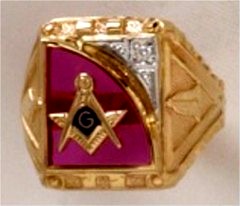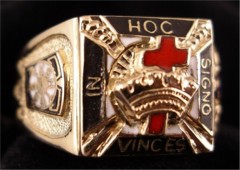 Although the primary mission of the Order was military, few members of the Knights Templar were actually combatants. Most Knights Templar’s acted in support positions to assist the knights and to manage the financial infrastructure. The Templar Order, though its members were sworn to individual poverty, was given control of wealth beyond direct donations. A nobleman who was interested in participating in the Crusades might place all his assets under Templar management while he was away. Accumulating wealth in this manner, the Order in 1150 began generating letters of credit for pilgrims journeying to the Holy Land: pilgrims deposited their valuables with a local Templar preceptor before embarking, received a document indicating the value of their deposit, then used that document upon arrival in the Holy Land to retrieve their funds. This practice was an early form of banking, and may have been the first formal system to support the use of checks. This system improved the safety of those journeying to the Holy Land by making them less attractive targets for thieves, and also contributed immensely to the Templar coffers. They acquired large tracts of land, both in Europe and the Middle East; bought and managed farms and vineyards; built churches and castles; and were involved in manufacturing, import and export. The Templar’s had their own fleet of ships. Based on these types of donations and business dealings, the Templar’s established financial networks across much of Europe and the Middle East. An example of a Knights Templar Ring can be found amongst the many Masonic Rings illustrated at Fox Jewelry.
Although the primary mission of the Order was military, few members of the Knights Templar were actually combatants. Most Knights Templar’s acted in support positions to assist the knights and to manage the financial infrastructure. The Templar Order, though its members were sworn to individual poverty, was given control of wealth beyond direct donations. A nobleman who was interested in participating in the Crusades might place all his assets under Templar management while he was away. Accumulating wealth in this manner, the Order in 1150 began generating letters of credit for pilgrims journeying to the Holy Land: pilgrims deposited their valuables with a local Templar preceptor before embarking, received a document indicating the value of their deposit, then used that document upon arrival in the Holy Land to retrieve their funds. This practice was an early form of banking, and may have been the first formal system to support the use of checks. This system improved the safety of those journeying to the Holy Land by making them less attractive targets for thieves, and also contributed immensely to the Templar coffers. They acquired large tracts of land, both in Europe and the Middle East; bought and managed farms and vineyards; built churches and castles; and were involved in manufacturing, import and export. The Templar’s had their own fleet of ships. Based on these types of donations and business dealings, the Templar’s established financial networks across much of Europe and the Middle East. An example of a Knights Templar Ring can be found amongst the many Masonic Rings illustrated at Fox Jewelry.
Fox Jewelry has some great alternatives to gold Masonic rings and other types of fraternal rings. Check out their selection of stainless steel masonic rings and sterling silver Masonic rings.
http://onlywire.com/r/67640975
Fox Jewelry has some great alternatives to gold Masonic rings and other types of fraternal rings. Check out their selection of stainless steel masonic rings and sterling silver Masonic rings.
http://onlywire.com/r/67640975
What is the proper way to wear a Masonic Ring? Should the points of the compass be toward or away from the body?
There are many opinions on this subject. To the best of my knowledge the Grand Lodges have not made any regulation on this subject.
“If you were hanging the American flag, would you put the stars down? The same holds true of the ring. It should look right side up to him. Rings are therefore worn with the points of the compass toward the wearer.”
Another opinion is that “When the emblem of the square and compasses is displayed on a building, pennant, button, watch charm etc., universal custom requires the points of the compass point downward. When displayed on the Altar they point away from the Master. As the Master from his station views the compass from the Altar of his lodge, the points are from, not towards him. As the wearer of a compass watch charm views it, the points are down and away from his eyes. In a similar way as he views the emblem on his ring the points should be down or away from his eyes.
The square is the symbol of earthly, the compass of heavenly perfection. As a combined emblem the ends of the square point up as a symbol of man’s aspirations toward God; the points of the compass are down to represent heavenly qualities coming down from God to earth. Therefore it would seem that the proper way to wear a ring would be that is which its symbolism is best expressed; namely, that in which, when the hand is held in its usual position the points of the compass are towards the earth and away from the wearer’s eyes.
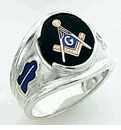 With ever increases in gold prices, Fox jewelry introduces it new line of stainless steel Masonic Rings, Sterling Silver Masonic Rings and gold plated Masonic Rings.
With ever increases in gold prices, Fox jewelry introduces it new line of stainless steel Masonic Rings, Sterling Silver Masonic Rings and gold plated Masonic Rings.
 George Washington became a Mason at age 20 in 1752 in the Lodge at Fredericksburg, Virginia. The first entry is thus: “Nov. 4th. 1752. This evening Mr. George Washington was initiated as an Entered Apprentice,” receipt of the entrance fec, amounting to £23s., was acknowledged, F.C. and M.M. March 3 and August 4, 1753. He may have attended about 9 lodge meetings during the remaining 46 years of his life, and probably never presided over any lodge.
George Washington became a Mason at age 20 in 1752 in the Lodge at Fredericksburg, Virginia. The first entry is thus: “Nov. 4th. 1752. This evening Mr. George Washington was initiated as an Entered Apprentice,” receipt of the entrance fec, amounting to £23s., was acknowledged, F.C. and M.M. March 3 and August 4, 1753. He may have attended about 9 lodge meetings during the remaining 46 years of his life, and probably never presided over any lodge.
However, George Washington wrote letters in which he said he was happy to be a Mason, and also, in 1791, describing Masonry as being “founded in justice and benevolence,” and “the grand object of Masonry is to promote the happiness of the human race.”
But, when he was asked more specifically about Freemasonry in 1798, he wrote, “. . . So far as I am acquainted with the principles and Doctrines of Free Masonry, I conceive them to be founded on benevolence and to be exercised for the good of mankind. It is not know whether George Washington wore a Masonic Ring. Examples of Masonic Rings can be found at: Fox Jewelry.
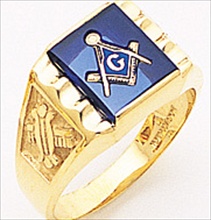 An implement of Operative Masonry, which has been adopted by Speculative Freemasons as the peculiar working-tool of the Master’s Degree. By this implement, and its use in Operative Masonry to spread the cement which binds all the parts of the building into one common mass, we are taught to spread the cement of affection and kindness, which unites all the members of the Masonic family, wheresoever dispersed over the globe, into one companionship of Brotherly Love and an old custom in an Oxford Lodge, England, gave it prominence as a jewel, and as a symbol it goes back to the practice of the Ancient.
An implement of Operative Masonry, which has been adopted by Speculative Freemasons as the peculiar working-tool of the Master’s Degree. By this implement, and its use in Operative Masonry to spread the cement which binds all the parts of the building into one common mass, we are taught to spread the cement of affection and kindness, which unites all the members of the Masonic family, wheresoever dispersed over the globe, into one companionship of Brotherly Love and an old custom in an Oxford Lodge, England, gave it prominence as a jewel, and as a symbol it goes back to the practice of the Ancient.
Today this implement is considered the appropriate working-tool of a Master Mason, because, in Operative Masonry, while the Apprentice is engaged in preparing the rude materials, which require only the Gage and Gavel to give them their proper shape. the Fellow Craft places them in their proper position by means of the Plumb, Level, and Square; but the Master Mason alone, having examined their correctness and proved them true and trusty, secures them permanently in their place by spreading, with the trowel, the cement that irrevocably binds them
together. The Trowel has also been adopted as the jewel of the Select Master.
But its uses in this Degree are not symbolical. They are simply connected with
the historical legend of the Degree. An example of the trowel can be found on most of the Master Mason Rings
– Source: Mackey’s Encyclopedia of Freemasonry
 We don’t believe in Pay Per Click Ads. Our page ranking is determined by the amount of traffic that we have on our site as well as the number of external links and happy customers. We at Fox Jewelry continue to bring you the largest selection of Masonic Rings and other Fraternal Rings at the best prices possible.
We don’t believe in Pay Per Click Ads. Our page ranking is determined by the amount of traffic that we have on our site as well as the number of external links and happy customers. We at Fox Jewelry continue to bring you the largest selection of Masonic Rings and other Fraternal Rings at the best prices possible.
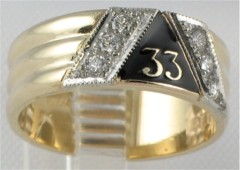 The Ancient and Accepted Scottish Rite of Freemasonry, commonly known as simply the Scottish Rite, is one of several Rites of the worldwide fraternity known as Freemasonry. A Rite is a series of progressive degrees that are conferred by various Masonic organizations or bodies. The Scottish Rite is one of the bodies of Freemasonry that a Mason may join for further exposure to the principles of Freemasonry. An example of the 33rd Degree Scottish Rite ring can be found at Fox Jewelry.
The Ancient and Accepted Scottish Rite of Freemasonry, commonly known as simply the Scottish Rite, is one of several Rites of the worldwide fraternity known as Freemasonry. A Rite is a series of progressive degrees that are conferred by various Masonic organizations or bodies. The Scottish Rite is one of the bodies of Freemasonry that a Mason may join for further exposure to the principles of Freemasonry. An example of the 33rd Degree Scottish Rite ring can be found at Fox Jewelry.
Essentially the Masonic Apron is the badge of honorable labor. The right to wear it is given only the most honorable of tried and trusted men. Much has been written on these meanings of the symbol. As the apron of all sorts, sizes and colors was an article of sacred investure in many of these, so is it in ours. What is truly important is the apron itself; what is less important is its size and shape, its method of wearing. Material and color are symbolic, but a Freemasons may be – and has been many – “properly clothed” with a handkerchief tucked about his middle, and it is common practice to make presentation aprons, most elaborately designed and embellished, without using leather at all, let alone lambskin. An example of the Masonic Apron can be found at Fox Jewelry.
